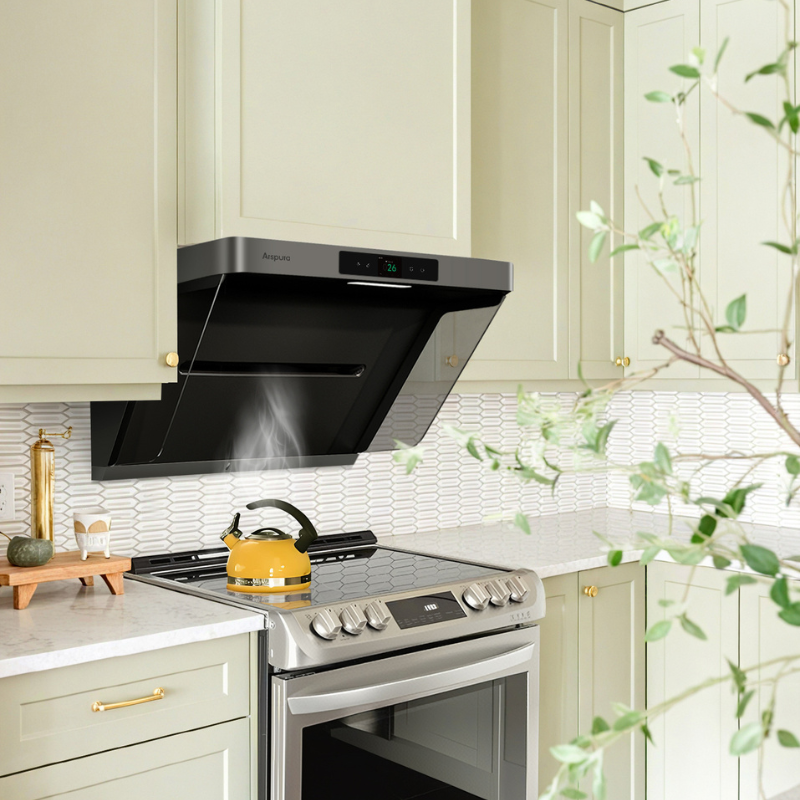Kitchen Air and Grease, Solved: A Practical Playbook from Odors to Cleanup

Just had a good meal. But now your house smells like you've been cooking all day. A thick layer of grease also clings to your stove and cabinets. This is a frequent issue. Seemingly, you have to resign yourself to it if want a home-cooked meal. That's also untrue. This guide will provide you with an overall plan. It will illustrate how to prevent and clean up the mess. So you'll have a new, fresh kitchen again.
Know Your Enemy: The Truth About Cooking Fumes and Grease
To win the battle against kitchen grime, you first need to understand your opponent. When you cook, especially with high heat, oils break down into more than just steam. You’re releasing a complex mix of airborne grease particles, odorous gases, and invisible pollutants.

This isn't just a cleaning issue; it's an air quality concern. Research from authorities like the U.S. Environmental Protection Agency (EPA) confirms that cooking is a primary source of indoor air pollution. Without good ventilation, harmful particles like lung-damaging PM2.5 and Volatile Organic Compounds (VOCs) can build up to levels far exceeding outdoor air.
What you can't see harms your air, while the airborne grease eventually cools and settles, creating that stubborn, sticky film on every surface that is so difficult to clean.
Part 1: The Source Control Strategy - Prevention is Key
To combat kitchen air and grease, it's always best to prevent it before it begins. A good preventive plan will get you out of a world of scrubbing later in life.
Your Most Powerful Weapon: Choosing the Right Range Hood
Your range hood is your most important piece of equipment. A good kitchen ventilation system works to contain smoke, steam, and grease. It does this before they get a chance to go all around your home.
Ducted is Always Better (Venting Outside)
In selecting a range hood, you'd like to know how much it interfaces with the air. A ducted range hood ranks first in selection. It sucks in the dirty air. It then releases it straight out of your house through a duct. A ductless version simply inhales the air with a filter. Then it releases the air into the kitchen again. It may reduce some odors. But it doesn't get rid of the grease particles much.
Airflow Speed > CFM (What Really Matters)
Lots of brands boast a high CFM figure. This refers to how much air the hood's able to ventilate. A high velocity of airflow, however, may be more fundamental. Powerful, high-velocity air provides the suction you require. This enables it to intercept fumes at the point of origin. A good-quality hood with high velocity will always perform better than a high-volume/low-velocity model.

Modern systems, for example, leverage this principle to great effect. Advanced range hoods like those with Arspura's IQV™ technology use airflow speeds of up to 13-15 m/s to create an invisible air curtain around the cooktop. This high-speed barrier locks smoke and grease in at the source, preventing them from ever reaching your cabinets and ensuring your kitchen stays cleaner with far less effort.
Smart Cooking Habits to Reduce Fumes
- Use the Right Oil: You should choose cooking oils with a high smoke point for high-heat cooking.
- Control the Heat: You should not let your oil get so hot that it makes a lot of smoke.
- Use Your Hood Correctly: You should turn your range hood on a few minutes before you start cooking. This gets the air flowing. You should also leave it on for 5-10 minutes after you are done. This helps remove cooking odors that are still in the air.
Part 2: The Tactical Cleanup - How to Conquer Stubborn Grease
You need a smart and good cleaning plan for the grease that is already there.
Your Grease-Fighting Toolkit: The Best Cleaners and Tools
You do not always need strong chemicals to clean grease. A simple paste made from baking soda and a little warm water can work very well. You can put it on greasy spots. Then let it sit for a few minutes to break down the grease. Then you can wipe it away. A commercial kitchen degreaser is a great choice for very tough jobs. You should also have the right tools. These include microfiber cloths, a soft sponge, and an old toothbrush.
A Step-by-Step Plan for a Sparkling Kitchen
It is important to know how to clean range hood grease and other kitchen surfaces the right way.
- Range Hood Filters: These get dirty fast. You can remove most metal filters. Then you can soak them in a sink of hot, soapy water with some baking soda. Let them soak for 15-20 minutes. Then you can scrub them with a brush and rinse them well.
- Cabinets: You should use a gentle cleaner for wood or painted cabinets. A spray bottle with a mix of white vinegar and warm water works well. You can spray it on, let it sit for a minute, and then wipe it clean.
- Stovetop and Backsplash: You can use your baking soda paste or a degreaser for these spots. You should let the cleaner sit on the surface for a few minutes before you start scrubbing.

Part 3: The Air Purification Plan - Banish Lingering Odors
Some smells can stay even if you have a good range hood. Here are a few good ways to remove cooking odors that have escaped.
- Cross-Ventilation: The easiest way is often the best. You can open windows on opposite sides of your home. This creates a breeze that will quickly clear out the air.
- Simmer Pot: A natural way to freshen the air is to boil a small pot of water on the stove. You can add things like lemon slices or cinnamon sticks.
- Activated Charcoal: You can place a few bags of activated charcoal in your kitchen. They are very good at soaking up and getting rid of smells over time.
Your Weekly/Monthly Kitchen Playbook
Doing a little bit of cleaning often is the secret to a clean kitchen. You can follow this simple plan to control grease and smells.
- After Every Meal: You should quickly wipe down your stovetop.
- Weekly: You should wipe down your cabinet fronts.
- Monthly: Deep clean your range hood filters. This is the most important job for good kitchen ventilation. Of course, investing in technology that minimizes this chore—like advanced filterless designs or systems that prevent grease from spreading in the first place—can make this playbook even easier to follow.
Stop Fumes at the Source, Clean Smart
A clean, fresh-smelling kitchen isn't a matter of luck—it's the result of a smart, two-part strategy: powerful prevention at the source and consistent, targeted cleaning. By understanding how to stop grease and odors before they take over, you spend less time scrubbing and more time enjoying the delicious meals you create.
If you're ready to win the battle against kitchen grease for good, upgrading your ventilation is the single most effective step. Explore how Arspura's high-speed IQV™ technology can transform your kitchen maintenance, locking away smoke and odors so you can cook with freedom and clean with ease.
FAQ
Q1: How often should I clean my range hood filters?
For average cooking habits, you should deep clean your metal grease filters at least once a month. If you do a lot of frying or high-heat cooking, cleaning them every two weeks is even better. A clean filter is the most critical part of effective kitchen ventilation.
Q2: My ductless (recirculating) range hood doesn't seem to help with smells. What can I do?
Ductless hoods are less effective at removing odors because they don't vent air outside. The key is to replace the charcoal filters regularly, typically every 3 to 6 months. These filters are what absorb the odors, and once they are saturated, they stop working.
Q3: What's the best way to clean very old, sticky grease off wooden cabinets?
For tough, old grease on wood, mix a paste of baking soda and a few drops of dish soap with warm water. Gently rub the paste onto the cabinet with a soft cloth, moving with the grain of the wood. Wipe it off with a clean, damp cloth and dry immediately. Avoid harsh chemicals that could damage the wood's finish.
